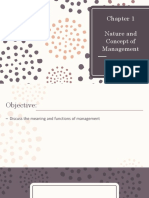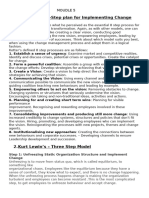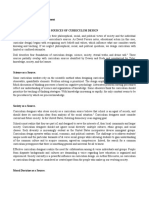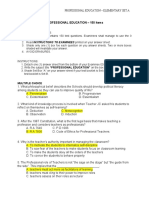91%(11)91% found this document useful (11 votes)
11K viewsA Presentation On Organizational Change Model
A Presentation On Organizational Change Model
Uploaded by
Kunwar Ajeet Singh BaghelThis document provides an overview of several models of organizational change:
1. It begins by summarizing Lewin's three-step change model of unfreezing, changing, and refreezing to initiate and stabilize change.
2. It then discusses Huse's seven-stage model which expands on Lewin's model with additional stages like scouting, entry, diagnosis, planning, action, stabilization and evaluation.
3. Finally, it outlines John Kotter's eight steps for successful change which includes increasing urgency, building a guiding team, communicating for buy-in, empowering action, creating short-term wins, and making change stick through reinforcement and culture change.
Copyright:
Attribution Non-Commercial (BY-NC)
Available Formats
Download as PPTX, PDF, TXT or read online from Scribd
A Presentation On Organizational Change Model
A Presentation On Organizational Change Model
Uploaded by
Kunwar Ajeet Singh Baghel91%(11)91% found this document useful (11 votes)
11K views16 pagesThis document provides an overview of several models of organizational change:
1. It begins by summarizing Lewin's three-step change model of unfreezing, changing, and refreezing to initiate and stabilize change.
2. It then discusses Huse's seven-stage model which expands on Lewin's model with additional stages like scouting, entry, diagnosis, planning, action, stabilization and evaluation.
3. Finally, it outlines John Kotter's eight steps for successful change which includes increasing urgency, building a guiding team, communicating for buy-in, empowering action, creating short-term wins, and making change stick through reinforcement and culture change.
Original Title
A Presentation on Organizational Change Model
Copyright
© Attribution Non-Commercial (BY-NC)
Available Formats
PPTX, PDF, TXT or read online from Scribd
Share this document
Did you find this document useful?
Is this content inappropriate?
This document provides an overview of several models of organizational change:
1. It begins by summarizing Lewin's three-step change model of unfreezing, changing, and refreezing to initiate and stabilize change.
2. It then discusses Huse's seven-stage model which expands on Lewin's model with additional stages like scouting, entry, diagnosis, planning, action, stabilization and evaluation.
3. Finally, it outlines John Kotter's eight steps for successful change which includes increasing urgency, building a guiding team, communicating for buy-in, empowering action, creating short-term wins, and making change stick through reinforcement and culture change.
Copyright:
Attribution Non-Commercial (BY-NC)
Available Formats
Download as PPTX, PDF, TXT or read online from Scribd
Download as pptx, pdf, or txt
91%(11)91% found this document useful (11 votes)
11K views16 pagesA Presentation On Organizational Change Model
A Presentation On Organizational Change Model
Uploaded by
Kunwar Ajeet Singh BaghelThis document provides an overview of several models of organizational change:
1. It begins by summarizing Lewin's three-step change model of unfreezing, changing, and refreezing to initiate and stabilize change.
2. It then discusses Huse's seven-stage model which expands on Lewin's model with additional stages like scouting, entry, diagnosis, planning, action, stabilization and evaluation.
3. Finally, it outlines John Kotter's eight steps for successful change which includes increasing urgency, building a guiding team, communicating for buy-in, empowering action, creating short-term wins, and making change stick through reinforcement and culture change.
Copyright:
Attribution Non-Commercial (BY-NC)
Available Formats
Download as PPTX, PDF, TXT or read online from Scribd
Download as pptx, pdf, or txt
You are on page 1of 16
A PRESENTATION ON
ORGANIZATIONAL CHANGE
MODEL
By Kunwar Ajeet Singh
Baghel
PGDM {HR} 3044
What is change??????
• Change is the law of nature . It is
necessary way of life in most
organizations for their survival and
growth. Man has to mould himself
continuously to meet new demand and
face new situations.
• Then the question arise what is the
organizational change ?
• the term ‘Organizational Change
implies the creation of imbalance in
the existence pattern or situation.
Reason for the Change
• Change in the organization is a must
whether brought about deliberately or
unwillingly. The reason for change are
categorized as follows, change in
business conditions, change in
managerial personnel, deficiency in
existing organizational patterns,
technological and psychological reasons,
government policies, size of the
organization.
Models of change
• Although there are a lots of change
models and theories have been
formulated by various experts and
management gurus but here we will give
a glance on few models of change
• At first we will discuss about Lewin’s
Three Step Change Model
Lewin’s Three Step
Change Model
• Most theories of organizational change
originated from the landmark work of
social psychologist Kurt Lewin. Lewin
developed a three ‑ stage model of
planned change which explained how to
initiate, manage, and stabilize the
change process. The three stages are
unfreezing, changing, and refreezing.
Continue……(from last slide)
• Let us now consider the three stages of
change.
• Unfreezing The focus of this stage is to
create the motivation to change. In so
doing, individuals are encouraged to
replace old behaviors and attitudes with
those desired by management. Managers
can begin the unfreezing process by
disconfirming the usefulness or
appropriateness of employees' present
behaviors or attitudes.
Continue……(from last
slide)
• Changing: Because change involves
learning, this stage entails providing
employees with new information, new
behavioral models, or new ways of
looking at things. The purpose is to help
employees learn new concepts or points
of view. Role models, mentors, experts,
benchmarking the company against
world‑class organizations, and training
are useful mechanisms to facilitate
change
Continue……(from last
slide)
• Refreezing Change is stabilized during
refreezing by helping employees
integrate the changed behavior or
attitude into their normal way of doing
things. This is accomplished by first
giving employees the chance to exhibit
the new behaviors or attitudes. Once
exhibited, positive reinforcement is used
to reinforce the desired. Additional
coaching and modeling also are used at
this point to reinforce the stability of the
change.
Edgar Huse’s seven stage
Model of Change
• In 1980, Edgar Huse proposed a seven-
stage OD model based upon the original
three-stage model of Lewin.
2. Scouting - Where representatives from
the organization meet with the OD
consultant to identify and discuss the
need for change. The change agent and
client jointly explore issues to elicit the
problems in need of attention.
3. Entry - This stage involves the
development of, and mutual agreement
Continue……(from last
slide)
3. Diagnosis - Here, the consultant
diagnoses the underlying organizational
problems based upon their previous
knowledge and training. This stage
involves the identification of specific
improvement goals and a planned
intervention strategy.
4. Planning - A detailed series of
intervention techniques and actions are
brought together into a timetable or
project plan for the change process. This
step also involves the identification of
Continue……(from last
5.
slide)
Action - The intervention is carried out
according to the agreed plans. Previously
established action steps are
implemented.
6. Stabilization & Evaluation - The stage of
'refreezing' the system. Newly
implemented codes of action, practices
and systems are absorbed into everyday
routines. Evaluation is conducted to
determine the success of the change
process and any need for further action is
established.
John P Kotter's 'eight steps
to successful change'
• Kotter's eight step change model can be
summarised as:
2. Increase urgency - inspire people to
move, make objectives real and relevant.
3. Build the guiding team - get the right
people in place with the right emotional
commitment, and the right mix of skills
and levels.
4. Get the vision right - get the team to
establish a simple vision and strategy,
focus on emotional and creative aspects
Continue……(from last
slide)
4. Communicate for buy-in - Involve as
many people as possible, communicate
the essentials, simply, and to appeal and
respond to people's needs. De-clutter
communications - make technology work
for you rather than against.
5. Empower action - Remove obstacles,
enable constructive feedback and lots of
support from leaders - reward and
recognise progress and achievements.
6. Create short-term wins - Set aims that
Continue……(from last
slide)
7. Don't let up - Foster and encourage
determination and persistence - ongoing
change - encourage ongoing progress
reporting - highlight achieved and
future milestones.
8. Make change stick - Reinforce the value
of successful change via recruitment,
promotion, new change leaders. Weave
change into culture.
Any Questions???
Thank You
You might also like
- Course Syllabus STR 581 4!17!12Document9 pagesCourse Syllabus STR 581 4!17!12Robert HarrisonNo ratings yet
- Lesson Plan in Front OfficeDocument3 pagesLesson Plan in Front OfficeSweety75% (4)
- The Permission Wheel Hawkes L PDFDocument8 pagesThe Permission Wheel Hawkes L PDFNandita Asthana SankerNo ratings yet
- Managing People and Organizations.: Assignment - Learning Outcome 01Document27 pagesManaging People and Organizations.: Assignment - Learning Outcome 01Namali De Silva0% (1)
- Organizational DevelopmentDocument12 pagesOrganizational DevelopmentShara Tumambing MA PsyNo ratings yet
- Navigating Change Through Formal Structure and SystemsDocument16 pagesNavigating Change Through Formal Structure and SystemsReich Barda RswNo ratings yet
- Maths Interview and Open TaskDocument4 pagesMaths Interview and Open Taskapi-317496733100% (1)
- Taboo Subjects Race Sex and PsychoanalysisDocument245 pagesTaboo Subjects Race Sex and Psychoanalysisshashisc100% (1)
- Course Syllabus - Facilitating Learner-Centered TeachingDocument2 pagesCourse Syllabus - Facilitating Learner-Centered TeachingMichelle F. De Guzman90% (10)
- Organizational ChangeDocument19 pagesOrganizational ChangeRIDDHI TAMBI100% (2)
- Models of Change Change ManagemntDocument20 pagesModels of Change Change ManagemntShehnaz Khan100% (1)
- Principle of Management - First Semester - 2023-2024Document9 pagesPrinciple of Management - First Semester - 2023-2024Maya Dana50% (2)
- The Importance of Human Relations in The Workplace: By: Matt PetryniDocument10 pagesThe Importance of Human Relations in The Workplace: By: Matt Petryniangel janine brojasNo ratings yet
- Organizational Change and Stress Management FinalDocument32 pagesOrganizational Change and Stress Management FinalQPL PAMBNo ratings yet
- PA03EHRM15 - Organizational DynamicsDocument1 pagePA03EHRM15 - Organizational DynamicsNinad100% (1)
- Basic Model of Strategic ManagementDocument14 pagesBasic Model of Strategic ManagementPrabhakar KumarNo ratings yet
- Unit 2 Conceptual Framework of Organizational DevelopmentDocument48 pagesUnit 2 Conceptual Framework of Organizational DevelopmentShiwangi Alind Tiwary100% (1)
- OD Meaning and ConceptsDocument8 pagesOD Meaning and ConceptsPriyanka Nema100% (1)
- Principles of ManagementDocument8 pagesPrinciples of ManagementSwapna KumariNo ratings yet
- CH - 2 - Product and Service DesignDocument62 pagesCH - 2 - Product and Service DesignYogesh GirgirwarNo ratings yet
- Characteristics of Organization DevelopmentDocument5 pagesCharacteristics of Organization DevelopmentroshanNo ratings yet
- Unit-2 Diversity ManagementDocument68 pagesUnit-2 Diversity ManagementAlisha DeltaNo ratings yet
- Organizational DevelopmentDocument49 pagesOrganizational DevelopmentMuhammad Risalat Siddique AlveeNo ratings yet
- Resistance To ChangeDocument8 pagesResistance To ChangeCyrilraincream100% (1)
- The Effect of Motivational Tools On Employees MoralsDocument17 pagesThe Effect of Motivational Tools On Employees MoralsOli AhmedNo ratings yet
- Case Study 1Document9 pagesCase Study 1Lyka NaboaNo ratings yet
- Using Teams in OrganizationsDocument11 pagesUsing Teams in OrganizationsShayne De TorresNo ratings yet
- Organisational DevelopmentDocument22 pagesOrganisational Developmentshubham singhNo ratings yet
- Evolution of Organization Theory PDFDocument2 pagesEvolution of Organization Theory PDFLueNo ratings yet
- Communication in Organizational Behavior PDFDocument2 pagesCommunication in Organizational Behavior PDFNathanNo ratings yet
- M.A. HRM (2009-11) - WebDocument47 pagesM.A. HRM (2009-11) - Webmahtab_aliNo ratings yet
- Chapter 10 Organizational Change and DevelopmentDocument22 pagesChapter 10 Organizational Change and DevelopmentJaya Raj JoshiNo ratings yet
- Leader As Coach: IL InternationalDocument17 pagesLeader As Coach: IL InternationalZaryna TohNo ratings yet
- Handout Organization and Management 2Document1 pageHandout Organization and Management 2Jophet Banabana MagalonaNo ratings yet
- CHAPTER 3 Managing Ethics & DiversityDocument51 pagesCHAPTER 3 Managing Ethics & DiversityMarisse Bagalay TejamoNo ratings yet
- Organisation Development Notes Unit-1Document2 pagesOrganisation Development Notes Unit-1Sreedharan Harshini33% (3)
- Group 6 PPT PRESENTATIONDocument58 pagesGroup 6 PPT PRESENTATIONElvie Jane Ligasan LauroNo ratings yet
- MANAGEMENT - MANAGEMENT PRINCIPLES AND APPLICATION 3rd SemDocument2 pagesMANAGEMENT - MANAGEMENT PRINCIPLES AND APPLICATION 3rd SemUzair ShahNo ratings yet
- Organizational Structure ReviewDocument26 pagesOrganizational Structure ReviewVergie TinduganNo ratings yet
- Module 6 Culture Lecture NotesDocument17 pagesModule 6 Culture Lecture Notes20174shravyarputhranNo ratings yet
- Human Resource ManagementDocument96 pagesHuman Resource ManagementHasanaat TahirNo ratings yet
- MG 1351 - Principles of Management 20 Essay Questions and AnswersDocument15 pagesMG 1351 - Principles of Management 20 Essay Questions and AnswersAnthony RollinsNo ratings yet
- Nature and Concept of ManagementDocument40 pagesNature and Concept of ManagementAr Anne UgotNo ratings yet
- Organizational Behavior Classic QuestionsDocument1 pageOrganizational Behavior Classic QuestionsMuhammed Dursun ErdemNo ratings yet
- Groups and Teams UgDocument50 pagesGroups and Teams UgSriparna ChatterjeeNo ratings yet
- Layout DecisionDocument5 pagesLayout DecisionMarjon VillanuevaNo ratings yet
- Organisational BehaviorDocument6 pagesOrganisational BehaviorIlamurugu PorchelvanNo ratings yet
- Arguments For and Against Social ResponsibilityDocument2 pagesArguments For and Against Social ResponsibilityTa Thi Thu VanNo ratings yet
- LeadershipDocument23 pagesLeadershipMostafa SakrNo ratings yet
- Capacity Buildng and EmpowermentDocument46 pagesCapacity Buildng and EmpowermentDERRICK OCHIENGNo ratings yet
- Why Ethics Matter CHAPTER 1 NOTESDocument3 pagesWhy Ethics Matter CHAPTER 1 NOTESAdil ArshadNo ratings yet
- Bio 407 - Basic EntomologyDocument79 pagesBio 407 - Basic Entomologyzombitrashh100% (1)
- Organizational Structure and Design: Presented by - Ashwani Solanki Praful Raj Manish Sangwan Mohit Ku JyotiDocument89 pagesOrganizational Structure and Design: Presented by - Ashwani Solanki Praful Raj Manish Sangwan Mohit Ku Jyotimohit sharmaNo ratings yet
- Lesson 4 OrganizingDocument25 pagesLesson 4 OrganizingJave CabilladaNo ratings yet
- Research Proposal ODDocument6 pagesResearch Proposal ODAnis Zaman100% (1)
- Historical Development of Organizational TheoryDocument14 pagesHistorical Development of Organizational TheoryMJaved KalburgiNo ratings yet
- ODDocument19 pagesODRachna RoomiNo ratings yet
- Types of Evaluation-ReviewedDocument23 pagesTypes of Evaluation-RevieweddmugalloyNo ratings yet
- Staffing - A Function of ManagementDocument5 pagesStaffing - A Function of ManagementSEBASTIAN NTI BINFONo ratings yet
- Human Capital Management Plan A Complete Guide - 2020 EditionFrom EverandHuman Capital Management Plan A Complete Guide - 2020 EditionNo ratings yet
- A Presentation On Organizational Change ModelDocument11 pagesA Presentation On Organizational Change ModelSwathi GrsNo ratings yet
- Change ModelsDocument16 pagesChange ModelsCainan OjwangNo ratings yet
- Final Module 6Document13 pagesFinal Module 6Suraj ReddyNo ratings yet
- MODULE5OBDocument2 pagesMODULE5OBPriyansu NayakNo ratings yet
- A Presentation On Organizational Change ModelDocument4 pagesA Presentation On Organizational Change ModelSandeepHacksNo ratings yet
- The Human Side of LeadershipDocument161 pagesThe Human Side of Leadershipmayur0% (1)
- Leadership Style of Mahatma GandhiDocument9 pagesLeadership Style of Mahatma GandhiKunwar Ajeet Singh Baghel92% (26)
- Leadership StyleDocument6 pagesLeadership StyleKunwar Ajeet Singh Baghel100% (1)
- LeadershipDocument15 pagesLeadershipKunwar Ajeet Singh Baghel80% (5)
- Leadership Styles2Document9 pagesLeadership Styles2Kunwar Ajeet Singh BaghelNo ratings yet
- CBSE Class 12 Psychology Question Paper 2023Document23 pagesCBSE Class 12 Psychology Question Paper 2023sg131021No ratings yet
- Running Header: Chapter 9 Motivation and Emotion 1Document7 pagesRunning Header: Chapter 9 Motivation and Emotion 1Jeffrey Michael AtencioNo ratings yet
- CYP1 Intro+DefinitionsDocument3 pagesCYP1 Intro+DefinitionsDiya AggarwalNo ratings yet
- ITC 571 - Emerging Technology - A3 - TemplateDocument8 pagesITC 571 - Emerging Technology - A3 - TemplateSHANMUGAM.K.P M.K.PNo ratings yet
- Pbpquestions Kaleigh ColtzerDocument3 pagesPbpquestions Kaleigh Coltzerapi-316891002No ratings yet
- Power of Energy HealingDocument4 pagesPower of Energy HealingBeyond ThoughtsNo ratings yet
- Understanding Yourself: What Is Your Dominant Decision-Making StyleDocument2 pagesUnderstanding Yourself: What Is Your Dominant Decision-Making StyleManvi GoelNo ratings yet
- SummaryDocument7 pagesSummarySamuel Allen L. GelacioNo ratings yet
- Pidato Bahasa InggrisDocument5 pagesPidato Bahasa InggrisYhaYha ZhynzhayNo ratings yet
- Observe 11 Reflective TeachingDocument5 pagesObserve 11 Reflective TeachingSuriia SeyfullahNo ratings yet
- Learning by The Case Method - Lecture 1Document14 pagesLearning by The Case Method - Lecture 1robin.asterNo ratings yet
- Website Skill Builders 1Document25 pagesWebsite Skill Builders 1bfoster2000No ratings yet
- Sources of Curriculum Design - NotesDocument4 pagesSources of Curriculum Design - NotesMarianne Parohinog100% (3)
- RRLDocument4 pagesRRLMark CornejoNo ratings yet
- Drugs, Crime & Sport: Mark Williams MSCDocument143 pagesDrugs, Crime & Sport: Mark Williams MSCMark Rees Williams100% (1)
- The Impact of New Media Technologies On Social Interaction in The HouseholdDocument30 pagesThe Impact of New Media Technologies On Social Interaction in The HouseholdPaoloNo ratings yet
- Learning TheoriesDocument95 pagesLearning TheoriesMuhammad Irfan100% (5)
- Questionnaire For INTERPERSONAL SKILLS OF ELEMENTARY EDUCATION STUDENTS OF PSU-URDANETA CAMPUSDocument133 pagesQuestionnaire For INTERPERSONAL SKILLS OF ELEMENTARY EDUCATION STUDENTS OF PSU-URDANETA CAMPUSVhi Da LynNo ratings yet
- 2526-Article Text-6813-1-10-20170126Document23 pages2526-Article Text-6813-1-10-20170126aishatzub5No ratings yet
- Professional Education - 150 Items: Multiple ChoiceDocument21 pagesProfessional Education - 150 Items: Multiple ChoiceStan ErjNo ratings yet
- Negative Effects and Impacts of Reality Shows On Children, Disadvantages of Reality Shows in TV ParentCircleDocument1 pageNegative Effects and Impacts of Reality Shows On Children, Disadvantages of Reality Shows in TV ParentCircleprathamgarg0037No ratings yet
- SD - Science 4 - Session 5Document60 pagesSD - Science 4 - Session 5Macver Santos San AgustinNo ratings yet
- Course Specification Level 3 Award in PTLLSDocument29 pagesCourse Specification Level 3 Award in PTLLSsalak946290No ratings yet
- A Process Oriented ApproachDocument216 pagesA Process Oriented Approachbhasi100% (1)
- Dream Interpretation Homework Not DoneDocument6 pagesDream Interpretation Homework Not Doneafmshobkx100% (1)






























































































